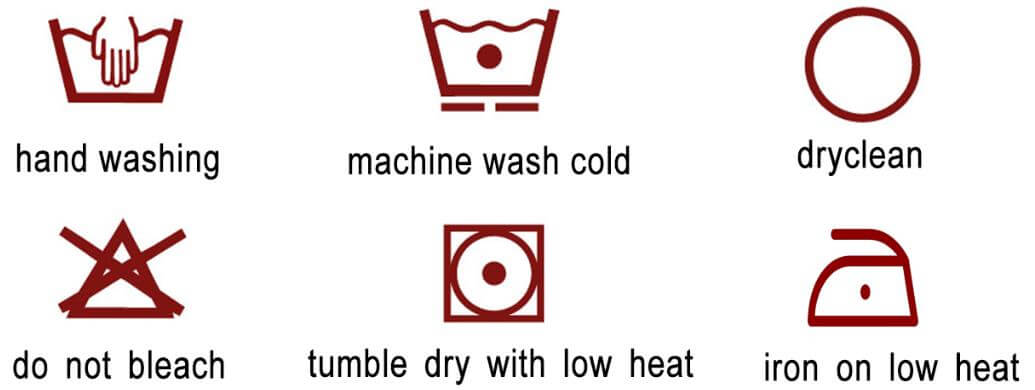Care Instructions

Product Features
- Despite great care taken during production, an exact colour consistency cannot always be guaranteed. The color of the actual product may vary slightly caused by lighting effects and monitor's brightness/contrast settings etc.
- Fluctuations of 1 – 3 % in repeat due to handmade and fabric width or length are customary and will not be recognized as cause for complaint.
- Please take into account a possible shrinkage between 1 – 3 %.
Usual variations in structure and equipment of the delivered goods may apply, unless these are justified by materials or by the manufacturing process. Shrinkages in a typical material scope do not justify a complaint. Because of changes in temperature and humidity, fabrics absorb moisture and this can result in stretching or shrinking. It is reasonable to expect as much as a 1 – 3% change in any curtain length or width. For some washable fabrics the shrinkage of up to 5% may also occur if washing instructions are followed
Tips: To reduce the possibility of shrinkage, washable fabrics should be hand-washed, drip dried and ironed in a lengthways direction before fully dry. Shrinkage in any fabric can be minimized if your curtains are dry-cleaned.
Note: We recommend the use of a light duty detergent without optical brighteners for all items in which, according to care instructions, washing is possible. A care label is sewn for every length. A care leaflet for your curtains is included with all orders. We recommend that this is kept for your future reference.
Different fabric types have different characteristics. 100% polyester fabrics have a tendency to “flare” out at the bottom. Silk by nature is a very delicate fabric and the texture of 100% silk is achieved by hand spun yarns which means that colour and texture variations can differ between two rolls. It is accepted that 100% silk cannot be guaranteed against fading from sunlight and therefore it is highly recommended lining be used.
Drapery fabrics containing cotton, rayon or viscose may crease more easily than their polyester counterparts but is in no way considered a flaw.
For more information, please click here.
How To Clean Curtains
What are they made of?
Since cleaning methods vary based on your curtain material, it’s essential to identify your curtain material before proceeding. If you are unsure, stick to the maintenance cleaning instructions (described at the bottom of this post) to avoid permanent damage.
Garment Fabric Curtains
- Remove all hardware.
- Shake outdoors if possible.
- Wash two panels at a time on the delicate cycle using the cold setting.
- Dry on a low-heat setting.
- Immediately remove from the dryer to prevent wrinkles and rehang.
Sheer Fabric or Lace Curtains
The lightweight fabric of these curtains makes them prone to wrinkling and snagging when they’re wet. For that reason, it’s best to hand wash them in a sink filled with cold water and one teaspoon liquid dish detergent.
- Shake outdoors to dislodge dust and pet hair.
- Wash one panel at a time by submerging it in the soapy water for 10 minutes then swirling to loosen debris.
- Drain, refill the sink with cold water and swirl the panel again to remove soap residue.
TIP: To restore a crisp feel to sheer or lace curtains, dissolve 1 cup of Epsom salt in a sink full of cold water. Submerge freshly-washed curtains for 10 minutes. Drain, gently press out any water but do not rinse. Let the curtains drip dry from your shower rod or laundry line and hang them.
Velvet Curtains
Some velvet curtains are machine washable while others require dry cleaning. Check the manufacturer’s label to find out which yours are.
- In general, lined velvet curtains should be treated as Dry Clean Only.
- Unlined velvet curtains require testing for colorfastness by dabbing a hidden area with a damp white washcloth. If the dye transfers to the cloth, take them to the dry cleaner. If the fabric is colorfast, wash them one panel at a time on the delicate cycle using cold water and half the usual amount of detergent.
- Freshly washed velvet curtains should be laid flat on a cotton sheet to dry, and never placed in the dryer.
Dry Clean Only Curtains
Formal or lined curtains may have a label saying they should be Dry Cleaned Only. If they’re expensive or you’re concerned about ruining them, by all means, take them to a trusted dry cleaner!
If they’re old and you’ve been thinking about replacing them because they’re so dingy looking, you can try washing them to see if there’s any improvement but know that washing may ruin them, so you’re assuming the risk.
- If you decide to wash Dry Clean Only curtains, do one panel at a time in the machine on the gentle cycle using cold water.
- Remove them from the machine immediately to keep the lining from wrinkling and then hang them on a laundry line or lay them flat to dry.
- Do NOT dry them in the dryer or the liner will most likely shrink.
Maintenance
Keep your curtains in good shape between washings with the following steps.
Weekly: Before cleaning a room, give the curtains a good shake to dislodge dust. Wait 10 minutes for the dust to settle before dusting furniture and vacuuming the floor.
Monthly: Once a month use the dust brush attachment on your vacuum to clean curtains from top to bottom, paying extra attention to the top 5 inches where the majority of dust accumulates. Do NOT use the upholstery attachment since its teeth may snag the fabric and destroy your curtains.
Monthly alternative: If vacuuming isn’t an option, you can also remove dust from curtains by running them through the dryer on a “no heat” (or fluff) setting for 5 minutes. Remove promptly and rehang to prevent wrinkles.